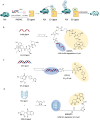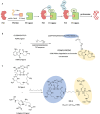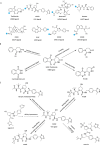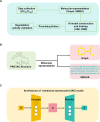Advancing Design Strategy of PROTACs for Cancer Therapy
- PMID: 40567248
- PMCID: PMC12188103
- DOI: 10.1002/mco2.70258
Advancing Design Strategy of PROTACs for Cancer Therapy
Abstract
Proteolysis targeting chimeras (PROTACs) have emerged as a groundbreaking class of anticancer therapeutics. These bifunctional molecules harness the endogenous ubiquitin-proteasome system to facilitate the degradation of targeted proteins of interest (POIs). Notably, the clinical translation of PROTACs has gained substantial momentum, with many PROTAC candidates targeting various cancers currently undergoing clinical trials (Phase I-III). However, the rational design of high-efficacy PROTAC compounds remains a significant challenge. In this review, we presented a comprehensive overview of POI ligands, E3 ligands, and their interconnected linkers in PROTAC design, including their generation, structural optimization, and contribution to degradation efficiency and selectivity. Particularly, we analyzed the distinct preferences of various types of POI ligands (small molecule, nucleic acid, and peptide) toward specific targets. Furthermore, we emphasized the significant role of artificial intelligence technology in PROTAC design, including POI/E3 ligands discovery and linkers generation or optimization. We also summarized the applications and challenges of PROTACs in cancer therapy. Finally, we discussed the future development of PROTAC by combining multidisciplinary technologies and novel modalities for cancer therapy. Overall, this review aims to provide valuable insights for advancing PROTAC design strategies for cancer therapy.
Keywords: E3 ligand; POI ligand; artificial intelligence; cancer therapy; linker design; proteolysis targeting chimeras (PROTACs).
© 2025 The Author(s). MedComm published by Sichuan International Medical Exchange & Promotion Association (SCIMEA) and John Wiley & Sons Australia, Ltd.
Conflict of interest statement
All authors declare no conflicts of interest.
Figures







Similar articles
-
Epigenetic therapy meets targeted protein degradation: HDAC-PROTACs in cancer treatment.Future Med Chem. 2025 Jul;17(14):1725-1737. doi: 10.1080/17568919.2025.2533113. Epub 2025 Jul 16. Future Med Chem. 2025. PMID: 40667573 Review.
-
Proteolysis-targeting chimera (PROTAC) nanomedicines toward cancer treatment: From synthesis to therapeutic delivery.Biomaterials. 2025 Aug 8;325:123621. doi: 10.1016/j.biomaterials.2025.123621. Online ahead of print. Biomaterials. 2025. PMID: 40819599 Review.
-
Methods to accelerate PROTAC drug discovery.Biochem J. 2025 Jun 25;482(13):921-37. doi: 10.1042/BCJ20243018. Biochem J. 2025. PMID: 40570202 Free PMC article. Review.
-
Targeted Protein Degradation in Lung Cancer: The Emerging Role of PROTAC Technology and E3 Ligases.Curr Med Chem. 2025 Jul 15. doi: 10.2174/0109298673382742250619055201. Online ahead of print. Curr Med Chem. 2025. PMID: 40671234
-
Advances in DNA-based proteolysis-targeting chimeras technology: Novel strategies for targeting previously undruggable proteins in cancer therapy.Bioorg Med Chem. 2025 Jun 28;129:118297. doi: 10.1016/j.bmc.2025.118297. Online ahead of print. Bioorg Med Chem. 2025. PMID: 40614626 Review.
References
-
- Glickman M. H. and Ciechanover A., “The Ubiquitin‐proteasome Proteolytic Pathway: Destruction for the Sake of Construction,” Physiological Reviews 82, no. 2 (2002): 373–428. - PubMed
Publication types
LinkOut - more resources
Full Text Sources
